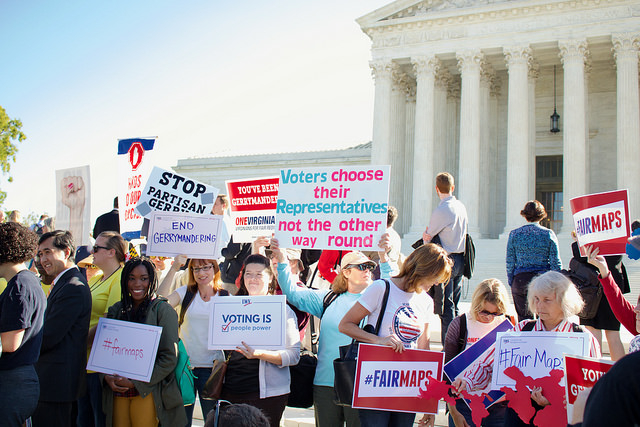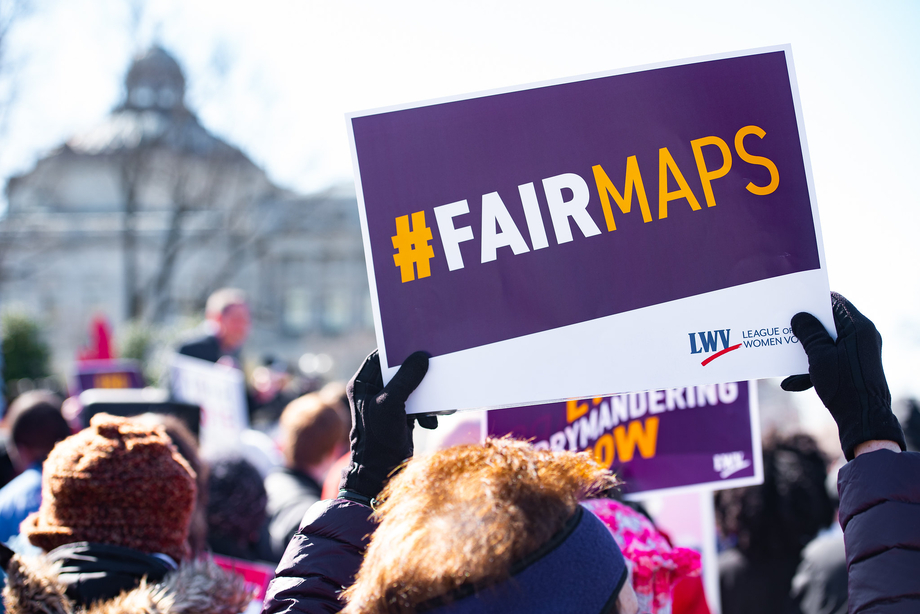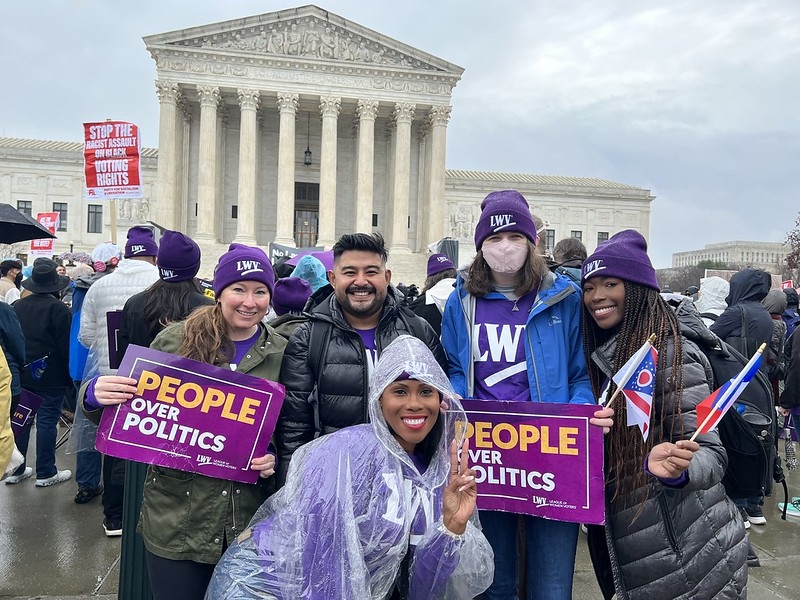How the Supreme Court Made Racial Gerrymandering Easier in Alexander v. South Carolina NAACP
On May 23, 2024, the Supreme Court decided Alexander v. South Carolina State Conference of the NAACP. This case concerned racial gerrymandering — placing voters in certain political districts based on their race to achieve a specific political result.
One would think that when a state engages in this practice, it violates the federal constitution because it discriminates based on race. This is what happened in South Carolina when the legislature moved 30,000 Black voters from one district and placed them into the state’s lone majority-Black district over 100 miles away. A three-judge district court found this violated the Fourteenth Amendment. But the US Supreme Court disagreed.
Stay Updated
Keep up with the latest in democracy. Receive emails to your inbox!
The Court instead decided the South Carolina legislature did not violate the Fourteenth Amendment’s prohibition on racial gerrymandering. In doing so, it not only deprived Black voters in South Carolina of a meaningful opportunity to elect candidates of choice outside of a single district but also made it easier for future legislative bodies to draw maps that harm voters of color.
The Court’s decision included concerning language regarding the future of voting rights litigation and voters’ ability to challenge racial gerrymandering. This blog explains the immediate impacts of this decision and its consequences for democracy.
What Was Alexander v. South Carolina State NAACP About?
Alexander concerned South Carolina’s First and Sixth Congressional Districts, which were redrawn after the 2020 Census. The Census requires all states to redraw their congressional districts to reflect population changes and ensure that each district is as evenly populated as possible.

The 2020 Census revealed that the First District was overpopulated by 87,689 residents, while the Sixth District was underpopulated by 84,741 residents. Congressional district populations must be as equal as possible to ensure equal representation in Congress. The Sixth District is the state’s only majority-Black district, represented by Democrat Jim Clyburn.
The First District became more competitive in 2018, flipping from a Republican to a Democrat, and back to being represented by a Republican, Nancy Mace, after 2020. But in redrawing the district lines to achieve an even population balance, the legislature deliberately moved Black voters between the two districts.
The South Carolina Conference of the NAACP and an individual voter, Taiwan Scott, challenged the map in federal district court. They argued that the South Carolina legislature impermissibly considered the race of voters to racially gerrymander the First District in violation of the Fourteenth and Fifteenth Amendments. A recent SCOTUS decision from 2017, Cooper v. Harris, decided that under the Fourteenth Amendment, states cannot organize their citizens into voting districts based on race. When a plaintiff alleges that a legislature drew a racial gerrymander, they must show that race was the main factor motivating the legislature’s decision-making when drawing a district’s lines.
A panel of three federal judges was appointed to preside over the trial. The panel found that South Carolina increased the population imbalance between the two districts by moving roughly 53,000 residents from the underpopulated Sixth District into the overpopulated First District. The mapmaker then split Charleston County between the two districts despite the area being a community of common interest. A community of common interest is an area of voters who share common policy concerns and benefit from being in a single district. The areas moved out of the First District included the cities of Charleston and North Charleston, where a large Black population resides. Meanwhile, the white neighborhoods went untouched.
The South Carolina legislature’s decisions moved over 60% of Black Charleston County residents into the Sixth District — over 30,000 Black residents. Nearly 80% of Charleson County’s Black population was placed in the Sixth District, when before, only 53% was included. The legislature’s decisions also moved 10 of the 11 precincts with the largest Black populations out of the First District into the Sixth District. These actions undermined Black voters by limiting their voting power to a single district.

The South Carolina legislature defended its actions at trial by saying they were driven by partisan, political motives to make the First District a safer Republican seat. Unlike racial gerrymanders, SCOTUS decided in Rucho v. Common Cause that partisan gerrymanders, despite their unfairness, cannot be challenged in federal court.
In January 2023, after a nine-day trial, the three-judge panel unanimously held that the South Carolina legislature engaged in unconstitutional racial gerrymandering. The court ruled the legislature drew those maps with a specific racial target of a 17% Black Voting Age Population (BVAP). The court found that the legislature’s racial target was a means to ensure the district would be safely Republican, violating the Equal Protection Clause. South Carolina then appealed directly to the United States Supreme Court.
For further background, visit this explainer on Alexander or this timeline of important events.
What Was SCOTUS’s Decision in Alexander?
The majority opinion, authored by Justice Alito, strayed from what SCOTUS has held in the past and set up new roadblocks for plaintiffs to challenge racial gerrymanders. Justice Alito’s argument hinged on three concepts:
The District Court’s decision was clearly erroneous in its findings of fact.;
The South Carolina legislature acted in good faith, and did what it believed was best, even when it admitted it was gerrymandering to rig maps for Republicans; and
Plaintiffs needed to submit an alternative map or suffer an adverse inference against them in court.
So, what does all this mean?
Clear Error Standard
The first issue revolved around what is called the “clear error standard.” Essentially, this is a self-imposed rule on SCOTUS to dissuade it from constantly overturning lower courts’ decisions. SCOTUS must give a lower court’s decision significant deference and uphold the decision if it is believable based on everything presented at trial. For a reversal, there must be a glaring mistake about the facts that leaves the Court with a definite and firm conviction to overturn.

Justice Alito threw any deference to the lower court’s decision out. A large portion of the opinion he wrote criticized the plaintiffs and the evidence they presented, which included four expert witnesses and their reports. Justice Alito wrote that all plaintiffs had was flawed, circumstantial evidence. The district court panel was then criticized for using weak inferences to draw its conclusions.
Throughout the opinion, Justice Alito attempted to discredit the four expert reports. Each report did something wrong in Justice Alito’s eyes. Justice Alito substituted his own opinions on the methods and statistics — despite not being an expert mapmaker — sharing his opinions on what the experts should have done or how the evidence should have been read. At one point, Justice Alito criticized one expert for relying on “precinct-level analysis” rather than individual voters; soon after, he criticized another expert for the opposite approach.
Justice Kagan, writing for the dissent, accused the majority of engaging in “irresponsible” conduct by “cherry-pick[ing] evidence, ignor[ing] credibility findings, misunderstand[ing] expert views, and substitut[ing] its own statistical theories.” Even Justice Thomas’s concurrence criticized the majority for arguing its own interpretation of the facts in the record.
District courts have the advantage of seeing everything in person, such as how an expert witness responds to questioning about their reports and decisions. Here, the district court, after hearing all the witnesses and seeing all the evidence presented, decided the plaintiff’s experts were more credible than South Carolina’s. The Supreme Court’s decision demonstrates Justice Alito’s willingness to ignore the clear error standard and refusal to respect trial courts in their decisions.
The Presumption of Legislative Good Faith
Another issue centered on the presumption of legislative good faith. This presumption means that courts will favor the decisions of state legislators over plaintiffs when they engage in redistricting which be seen as a toss-up over whose side to believe. Any possibility that favors the State, the majority says, should be determinative, with the State’s argument prevailing. The majority’s reasoning was partially rooted in its concern over offending another political branch by finding it engaged in offensive conduct “resembling political apartheid.”

Justice Thomas, however, went further; he endorsed the concept of the independent state legislature theory, which was recently defeated in Moore v. Harper. The independent state legislature theory asserts that state legislatures have exclusive power over redistricting, and state courts can't review congressional gerrymanders. In his concurrence, Justice Thomas said deciding racial gerrymanders goes beyond the remedial powers the Constitution gives SCOTUS.
Shockingly, Justice Thomas wrote that even Brown v. Board of Education, the landmark case that deemed school segregation unconstitutional, was an example of SCOTUS going beyond its remedial powers. Justice Thomas would prefer never to hear a case about racial gerrymanders and give state legislatures free rein to create any map they want—at the cost of giving voters free and fair maps.
The dissent pushed back against the majority’s presumption of legislative good faith. Justice Kagan chastised the majority for protecting a handful of legislators over thousands of voters, writing, “if calling out a racial gerrymander accuses a state of grave wrong, then so be it. This Court is not supposed to be so fearful of telling discriminators, including States, to stop discriminating.” That is how representative democracy should work — by protecting the voices of the masses over the self-interested motives of a select few.
The majority’s opinion in Alexander means in lawsuits going forward is that the legislature will receive the benefit of the doubt on any piece of evidence presented that may show they engaged in unconstitutional conduct.
Requiring an Alternative Map
Lastly, the majority stated that plaintiffs must submit an “alternative map.” This alternative map would need to show that the district could be drawn in a way that allows a legislature to achieve its alleged partisan goals and supports the plaintiff’s goals. If a plaintiff fails to do this when they lack direct evidence of the legislature using race to gerrymander congressional maps, then the majority will essentially reprimand the plaintiffs and favor the legislature.
Here’s the catch about this alternative map requirement: Justice Alito already proposed this once in Cooper v. Harris (see above) — in a dissent. As Justice Kagan points out, plaintiffs have never been asked to provide a specific piece of evidence in racial gerrymander cases or risk losing the case. Yet, in Alexander, the majority punished the plaintiffs for doing what the law allowed.
Plaintiffs already face significant burdens fighting racial gerrymandering. Justice Alito’s opinion overlooks the difficulty and cost of getting experts to produce alternative maps. Voting rights litigation is already costly and slow-moving, as the Court has chipped away at various protections, requiring significant time commitments for plaintiffs and their attorneys. If plaintiffs are required to find experts to help them draw alternative maps, it only increases the cost and time of the litigation. These cases have high stakes, so plaintiffs want to ensure they get experts. If cases require the additional resource of alternative maps, some plaintiffs may be unable to afford experts. This new requirement of an alternative map forces plaintiffs to jump through more hoops to challenge racial gerrymanders.
Returning Power to the People
This decision represents a continued trend of silencing the voices of voters by aiding and abetting anti-democratic legislatures. While there have been some wins from the Supreme Court, they’ve come too close for comfort and continue to be challenged.
Support our legal work!
In Allen v. Milligan, a 5-4 majority protected Section 2 of the Voting Rights Act and required Alabama to counter a racially gerrymandered map by drawing a second majority-Black congressional district, which led to a similar victory in Louisiana. In response, white voters from Louisiana challenged the drawing of a second majority-Black district in their state, which was overturned by a three-judge district court panel. SCOTUS issued an emergency stay, so the second majority-Black district will exist through the 2024 general election. However, its fate afterward is unclear.
Even though the independent state legislature theory was shut down in Moore v. Harper by a 6-3 vote, Justice Thomas still wishes to give life to the dangerous proposition. SCOTUS has held that they cannot hear political gerrymanders, allowing parties to make races less competitive and fortify illegitimate majorities. Brnovich v. Democratic National Committee, also authored by Justice Alito, makes it harder to challenge voter suppression under Section 2 of the Voting Rights Act, causing greater disparities in who has easy access to voting.
The decision in Alexander is a setback for voters and fair and transparent redistricting. When plaintiffs challenge a racial gerrymander, it will be much harder for them to win. In those cases, the court will presume that the legislature drew the lines in good faith instead. Plaintiffs will need a specific piece of evidence that, in part, helps the legislature prove that a partisan gerrymander took place. And if plaintiffs fail to provide that evidence, the court will infer against the plaintiffs’ arguments.
As Justice Kagan ended, “in the electoral sphere especially, where ugly patterns of pervasive racial discrimination have so long governed, we should demand better – of ourselves, of our political representatives, and most of all of this Court.” The best way to demand better is to make our voices heard at the polls, despite the adversity. We need to advocate for Congress to pass legislation to prevent racial gerrymandering and to remedy the Court’s similar anti-democratic rulings like Rucho v. Common Cause and Brnovich v. Democratic National Committee. Those pieces of legislation include the John Lewis Voting Rights Advancement Act (JLVRAA), the Freedom to Vote Act (FTVA), and the Native American Voting Rights Act (NAVRA).
The Latest from the League
WASHINGTON, DC —Today, the League of Women Voters of the United States joined an amicus brief filed by the Lawyers' Committee for Civil Rights Under Law in Alexander v. South Carolina State Conference of the NAACP, a racial gerrymandering case to be heard before the Supreme Court of the United States this fall. The brief is also joined by the Leadership Conference on Civil and Human Rights, the Leadership Conference Education Fund, Asian Americans Advancing Justice | AAJC, Asian American Legal Defense and Education Fund, Campaign Legal Center, Demos, and the Southern Coalition for Social Justice.
The Supreme Court’s 5-4 ruling this week leaves the country vulnerable to the very forms of voter suppression Congress warned of in 2006.
The League is invested in and carefully watching an important redistricting case, Alexander v. South Carolina State Conference of the NAACP. The case is an appeal from a ruling striking down South Carolina’s congressional map as an unconstitutional racial gerrymander.
Sign Up For Email
Keep up with the League. Receive emails to your inbox!
Donate to support our work
to empower voters and defend democracy.





